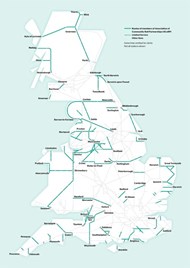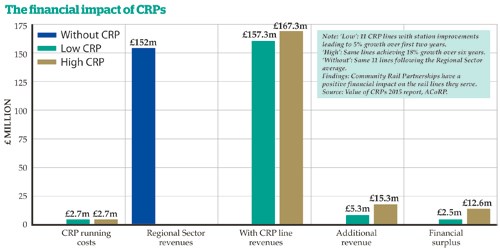 Read the peer reviews for this feature.
Read the peer reviews for this feature.
Download the graphs for this feature.
The British public has spoken and we know where we are for the next five years, in political terms. The new Conservative majority government is likely to continue its existing policies, which have been broadly supportive of rail. Scotland and Wales have their own elections next year, but the positive approach towards rail development, from their respectively SNP and Labour-led governments, is likely to continue.
But what of ‘community rail’, which mainly (but not exclusively) covers those routes that are subsidy-dependent and which have in the past been subject to closure attempts? The numbers are significant and far from marginal. Community rail lines and services are a significant part of the national network, accounting for around 40 million journeys per year. Will there be a renewed threat to their existence, as the Government tries to deliver its £30 billion-worth of cuts?
The Department for Transport will certainly have to shoulder its share of the burden, but there are strong grounds to hope that community rail routes and services will escape unscathed. They are a success story, with rising passenger numbers, with rail making a real contribution to local economies and communities.
Research has shown that Community Rail Partnerships (CRPs) more than pay for themselves, adding economic, social and environmental value to the communities they serve. They operate in deprived inner-urban areas as well as more remote rural communities with a high dependence on their local rail service. And passenger use on community rail lines has grown by nearly 3% a year on top of the ‘normal’ growth on non-CRP lines.
So why risk a public outcry in this politically sensitive area, knowing that any savings from line closures or service reductions would be a drop in the ocean of rail subsidy? In all likelihood, community railways are safe for the foreseeable future. But the question is: how can they now go forward and improve yet further on the success of the past 20 years?
The evolution of community rail
Many of the best ideas are developed in pubs. Huddersfield’s Head of Steam could be said to be the spiritual home of community rail - it was here, back in the early 1990s, where pints of Yorkshire beer stimulated discussion on how to develop local railways in slightly unconventional ways (such as the hugely successful music trains on the Penistone Line).
And it was in the Head of Steam ten years later, in 2004, that former railways minister Tony McNulty launched the Government’s Community Rail Development Strategy.
In the intervening decade, ‘community rail’ had grown from a good idea into a well-demonstrated means of promoting the greater use and relevance of local railways up and down the country, mostly in England and Wales.
The first CRP was the Devon & Cornwall Rail Initiative (now Partnership), formed in the early 1990s and involving a partnership of local authorities, BR and the University of Plymouth to promote the network of local branch lines in the South West. It has maintained its role as one of the pre-eminent rail development partnerships in the UK, extending its operations to most routes in the region.












